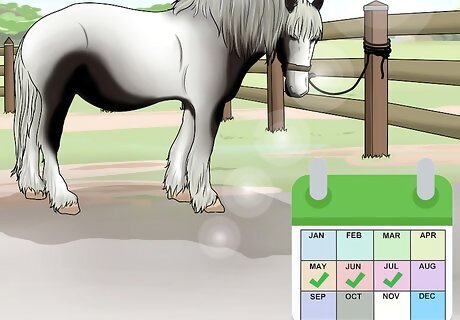
views
Planning to Breed Your Horse

Calculate the financial cost of impregnating your horse. Know that there is a considerable amount of cost involved with breeding a horse. There are fees for the stallion to breed with the mare, plus insurance costs to protect you should the mare kick out and damage the stallion, plus transport costs to get the mare to the stallion and back. Bear in mind that she may not become pregnant on the first attempt and so this may need to be repeated. Instead of using a stallion, you can also opt for artificial insemination. This process, in which semen is inserted directly the mares uterus, will require you to pay for the semen, which stallion owners sell, as well as the procedure to implant it.

Calculate the potential veterinary costs related to pregnancy. Be aware there are veterinary costs involved to check that the mare is well enough to establish a pregnancy and is free from uterine infections, for pregnancy diagnosis, vaccination against equine herpes virus, tetanus, West Nile virus, and equine encephalitis, during pregnancy, and the cost of covering any complications with foaling.

Calculate additional costs. All in whole do not go into breeding from some misty eyed idea of "it would be nice" but have a solid reason for producing a foal. For example, any difficulties during foaling can lead to long-term problems or death of the foal, so if you are breeding for the first time it is advisable to send the mare to a foaling facility where she can be kept under constant surveillance during the last month of her pregnancy. These facilities are expensive and you can expect to pay around $300-500 for the foaling plus the cost of her board for a month. Indeed, you will also incur additional costs for consumables, such as feed (in the last third of pregnancy), stabling, bedding, and electricity. Then when you have a live healthy foal, it is going to be at least two years until you can saddle the animal, and you have no guarantee of its temperament, so it may not be suited for the purpose for which you bred it.

Figure out when the mare will be ready to mate. The mare is a seasonal breeder, which means that increasing daylight length stimulates her brain to produce hormones that bring her into heat. The mare typically cycles (has heat periods) from spring through to late summer or early autumn. It is possible to artificially manipulate the mare's reproductive cycle by stabling her and exposing her to electric light in winter, which can bring on her heat cycles. This is sometimes done with thoroughbred mares, whose foals are intended for racing, as their birth date has implications for which racing classes they will be entered in.

Be sure the mare is the right age for breeding. The best age to breed a mare for the first time is once she has finished growing herself, at around three to four years of age. It is possible to breed from 18 months, but this places a lot of demands on the body of a mare that is still growing itself. At the other end of the scale, it can be more difficult to get a mature mare to fall pregnant for the first time.
Breeding the Mare

Get the mare impregnated at a time that will produce a foal in the late spring or early summer. The ideal time for a foal to be born is between May and July, when there is plentiful nutritious grass available for the mare to graze on which will benefit her milk supply. Thus, the best time to breed the mare is around June, July, and August, so that she foals 11 months later.

Have your mare tested for reproductive diseases if using a stallion. When using a stallion to cover a mare, the owner of the stallion will want to know that the mare is clean and does not have any transmissible equine reproductive diseases. They will expect the mare to be swabbed prior to mating. This is done by a veterinarian who swabs the vagina, usually during a heat cycle. The swab is sent to a lab where any organisms are cultured and identified.

Mate the mare and stallion or impregnate the mare with artificial insemination. Make sure your mare is in the prime time of her heat for reproduction. Each estrus cycle takes around 21 days, with the mare being in estrus or 'heat' for an average of 6 days in every 21. She ovulates and is therefore most likely to get pregnant one to two days before the end of the heat, but this does vary with individuals. For the maximum chance of conception ideally the mare would be covered by a stallion on day 2 or 3 after the beginning of heat, and continue on alternate days until the heat finishes. It can be tricky to know when a mare is coming into season. Some stud farms employ the use of "teaser" stallions who the mare can see but not reach. When she is in heat her hormones make her more interested in seeking male attention and so she may become flirtatious towards the male. In addition, a female horse coming into heat may show signs, such as increased interest in other horses, a change in temperament that is often characterized as moodiness, and increased frequency of urination.
Caring for a Pregnant Mare

Figure out if the mare is pregnant. It can be difficult to visually detect pregnancy, especially in stockier wide-framed mares. A swollen belly may not be evident until the final third of pregnancy, and even then, weight gain from additional food can be mistaken for a foal. The development of mammary glands is used in other species to indicate pregnancy, but again this may not happen in the horse until a month before foaling, and even then "bagging up" can be the result of a false pregnancy. To detect pregnancy a veterinarian can perform a transrectal ultrasound exam. A special probe is inserted into the rectum and the scan directed toward the uterus. This can be done from around 12 - 17 days after mating, to look for changes associated with pregnancy. If this option is not available then a blood test can be run from day 45 - 120, which looks for the presence of a hormone, equine chorionic gonadotropin, that is a marker of pregnancy. It should be noted that no test is foolproof and it is possible to get false positive results, however a negative test is definite confirmation that the mare is not pregnant.

Treat the pregnant mare pretty regularly for the first two thirds of the pregnancy. Pregnancy lasts just under a year and is on average 340 days with a leeway of 20 days in either direction considered normal. The mare should be fed her usual ration during the first two-thirds of the pregnancy. This is because being overweight at the time of birth is a major factor causing complications during foaling. The mare can be ridden during the first two-thirds of pregnancy, and indeed keeping her fit and well is an important part of building her stamina for foaling, which is an extremely physical event. If your mare will be grazing in a field, make sure it's free of fescue grass, which can cause fescue toxicity in pregnant mares. Talk to your vet about the proper nutrition for your mare, like whether you need to supplement their diet with salt blocks or vitamins.

Be careful with the mare during the end of her pregnancy. Carrying the growing foal will put a lot of strain on the mares body, so during the last third of a mare's pregnancy you should treat her more delicately. Don't ride her and feed her more food, which she will need to grow the foal.
Tending to a Mare in Labor

Be on the look out for the first signs of foaling. Mares usually foal at night, and seem to need dark and quiet in order relax enough to foal. The first stage of labor, where the uterus tones up and prepares to push the foal out, is characterized by restlessness and pacing, swishing the tail as if irritated, and general crankiness. During this time the position of the foal changes, getting ready to be presented into the birthing canal. You do not need to intervene with the horse at this point. It just means that you need to keep a closer eye on her once she goes into labor.

Observe closely, but don't interfere with, the second stage of labor. As the mare gets ready for second stage labor and pushing the foal out she will frequently break into a sweat. During this stage of labor the mare will lie down with her legs extended and push hard. She may stand and lie down again repeatedly during the process, until the foal is pushed out. Close observation is advisable during this stage, either by remote camera or by an observer sitting quietly out of the way with a torch.

Be prepared to call in a veterinarian. If the mare is straining hard with not progression of the foal for 20 - 40 minutes then immediate veterinary attention should be sought. It is best to have a veterinarian on standby for just this type of emergency during the birth.




















Comments
0 comment